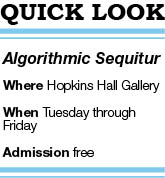
The world of fine art evolves as new media present themselves, giving artists new modes and environments for expression.
Given that premise, what better medium to work with than the medium of today: technology, asks Ken Rinaldo, professor and head of the Department of Art’s art and technology program.
Starting 5 p.m. Tuesday, a curious cluster of electronically produced art is plugging into Hopkins Hall Gallery for the Art + Technology program’s biannual student exhibition, “Algorithmic Sequitur,” which lasts through Dec. 12. The works were chosen from roughly 280 submissions by faculty members, Rinaldo said, with an acceptance rate of about 50 percent.
Jessica Ann, a second-year student and teaching associate in the art and technology MFA program, said creating art from technology is fascinating to her since she can explore emerging electronic materials, such as the electroencephalography headset, a wearable device that detects human brainwaves. EEG headsets have been examined for use in gaming and the medical field, Ann said, but she chose to use its components for something new: a brainwave-controlled video camera called the Biofeedback Cinema.

Click to enlarge.
“The system operates in lieu of a traditional cinematographer, and it’s the actor who will control the final composition with their brainwaves,” Ann said, adding that the system still needs further development before it’s truly complete.
Ann’s vision-turned-working-prototype uses a Neurosky EEG Reader headset to measure a subject’s brainwaves, which are sent via Bluetooth technology to her platform, ultimately controlling the focus and position of the camera, she said. For example, if the gadget detects the wearer is highly concentrated, the camera shot will be more focused.
“In some ways, you might say this is a normal way for artists to work today, because these are the tools of this moment,” assistant professor of art and technology Shane Mecklenburger said about the exhibit. “So I think it’s a very natural thing for artists to want to work with technology.”
Ann’s project was brought to existence after she was selected to go to Madrid for an engineering workshop, ”Interactivos.” There, she realized the Biofeedback Cinema in collaboration with a professional programmer, choreographer and videographer. Ann has since rebuilt the device, which will be in the exhibit. Theatre students Josh Truett and Karie Miller are set to perform live with Ann’s system during the show’s opening at 5, 5:30, 6 and 6:30 p.m.
Other artworks in “Algorithmic Sequitur” utilize digital imaging, 3-D holography, new media robotics, moving images, art games, animation, 3-D modeling, rapid prototyping work, among others, Mecklenburger said.
Students in art and technology have an advanced array of resources at their fingertips, including a laser cutter and a rapid prototyping machine, to help bridge the gap that occurs when a student has an idea, but not the engineering skills necessary to carry it out, Mecklenburger said. The lower cost and accessibility of these tools have led more and more artists to create in this field.
“There’s actually a wonderful relationship between the way artists and engineers think,” Rinaldo said. “Generally engineers have much higher math skills, but the truth is that with a lot of the software we use, we don’t necessarily have to have the high math skills to make engineered works of art.”
A related spectacle — the first of its kind — is set to be projected onto the dome of Ohio State’s planetarium thanks to students in Mecklenburger’s 3-D Experimental Animation course who have created astronomy inspired moving images for the event, titled “Findings.”
The screening will be held Wednesday and Thursday, both at 7 p.m., at OSU’s planetarium, which is located on the fifth floor of Smith Laboratory. It was funded by the Battelle Endowment for Technology and Human Affairs, given to the art and technology program in 2013.
“Mathematical objects and code-based interactions speak specifically to a kind of contemporary moment on this planet, where everything we know of is mediated by mathematical spaces or the algorithm,” Rinaldo said. “The algorithm is the new intelligence that mediates how we touch the world.”


